The science of creativity, the creativity of science, and what your internal clock has to do with Saudi Arabia.
Summer, with its steady supply of barbecues, picnics, parties, and other heavy doses of sociality, makes the need for a well-timed antidote of solitude more urgent than any other season, and what better solitary escape than a good book? It’s time for the annual Brain Pickings summer reading list for cognitive sunshine. Gathered here, in no particular order, are 10 recent and forthcoming books to infuse your season’s well-measured you-moments with a wealth of cross-disciplinary stimulation.
 MAGIC HOURS
MAGIC HOURS
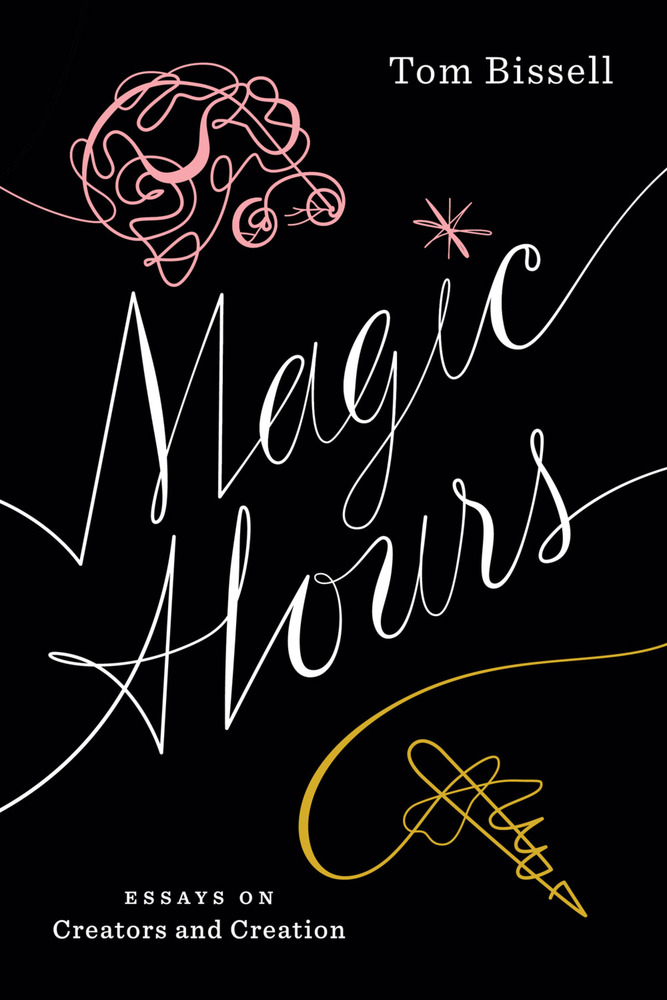 From McSweeney’s and Tom Bissell, one of today’s finest essayists, comes Magic Hours: Essays on Creators and Creation (public library) — a collection of fourteen essays originally published in arbiters of literary culture such as The New Yorker, Believer, and Harper’s Magazine, spanning a decade of Bissell’s best writing and dissecting the creative process through such diverse subjects as Werner Herzog’s films, video game voiceovers, Iraq war documentaries, sitcoms, and David Foster Wallace. Underpinning them is a somewhat uncomfortable reality to which just about any creator can attest — that no matter how meticulously we trace creativity’s history, dissect its neuroscience, flowcharting our way to it, and itemize it into a 5-point plan, the essence of creation remains subject to a great deal of uncontrollable chance and serendipity.
From McSweeney’s and Tom Bissell, one of today’s finest essayists, comes Magic Hours: Essays on Creators and Creation (public library) — a collection of fourteen essays originally published in arbiters of literary culture such as The New Yorker, Believer, and Harper’s Magazine, spanning a decade of Bissell’s best writing and dissecting the creative process through such diverse subjects as Werner Herzog’s films, video game voiceovers, Iraq war documentaries, sitcoms, and David Foster Wallace. Underpinning them is a somewhat uncomfortable reality to which just about any creator can attest — that no matter how meticulously we trace creativity’s history, dissect its neuroscience, flowcharting our way to it, and itemize it into a 5-point plan, the essence of creation remains subject to a great deal of uncontrollable chance and serendipity.To create anything — whether a short story or a magazine profile or a film or a sitcom — is to believe, if only momentarily, you are capable of magic. These essays are about that magic — which is sometimes perilous, sometimes infectious, sometimes fragile, sometimes failed, sometimes infuriating, sometimes triumphant, and sometimes tragic. I went up there. I wrote. I tried to see.A closer look, along with excerpts from some of the essays, here.
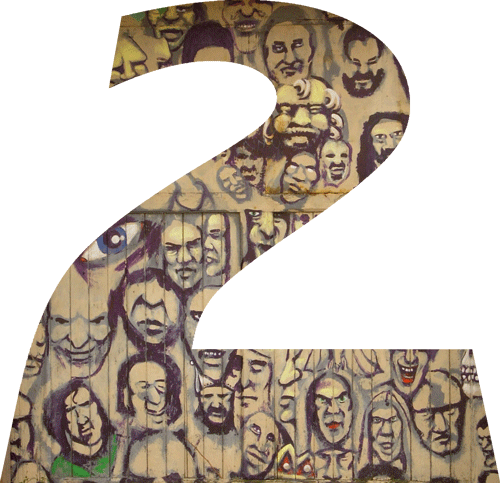 INTERNAL TIME
INTERNAL TIME
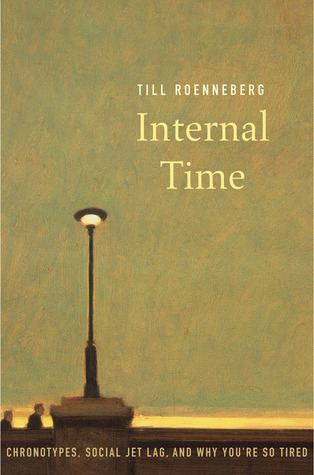 “Six hours’ sleep for a man, seven for a woman, and eight for a fool,” Napoleon famously prescribed. (He would have scoffed at Einstein, then, who was known to require ten hours of sleep for optimal performance.) This perceived superiority of those who can get by on less sleep isn’t just something Napoleon shared with dictators like Hitler and Stalin, it’s an enduring attitude woven into our social norms and expectations, from proverbs about early birds to the basic scheduling structure of education and the workplace. But in Internal Time: Chronotypes, Social Jet Lag, and Why You’re So Tired (public library), a fine addition to these 7 essential books on time, German chronobiologist Till Roenneberg demonstrates through a wealth of research that our sleep patterns have little to do with laziness and other such scorned character flaws, and everything to do with biology.
“Six hours’ sleep for a man, seven for a woman, and eight for a fool,” Napoleon famously prescribed. (He would have scoffed at Einstein, then, who was known to require ten hours of sleep for optimal performance.) This perceived superiority of those who can get by on less sleep isn’t just something Napoleon shared with dictators like Hitler and Stalin, it’s an enduring attitude woven into our social norms and expectations, from proverbs about early birds to the basic scheduling structure of education and the workplace. But in Internal Time: Chronotypes, Social Jet Lag, and Why You’re So Tired (public library), a fine addition to these 7 essential books on time, German chronobiologist Till Roenneberg demonstrates through a wealth of research that our sleep patterns have little to do with laziness and other such scorned character flaws, and everything to do with biology.In fact, each of us possesses a different chronotype — an internal timing type best defined by your midpoint of sleep, or midsleep, which you can calculate by dividing your average sleep duration by two and adding the resulting number to your average bedtime on free days, meaning days when your sleep and waking times are not dictated by the demands of your work or school schedule. For instance, if you go to bed at 11 P.M. and wake up at 7 A.M., add four hours to 11pm and you get 3 A.M. as your midsleep.

Sleep duration shows a bell-shaped distribution within a population, but there are more short sleepers (on the left) than long sleepers (on the right).
This myth that early risers are good people and that late risers are lazy has its reasons and merits in rural societies but becomes questionable in a modern 24/7 society. The old moral is so prevalent, however, that it still dominates our beliefs, even in modern times. The postman doesn’t think for a second that the young man might have worked until the early morning hours because he is a night-shift worker or for other reasons. He labels healthy young people who sleep into the day as lazy — as long sleepers. This attitude is reflected in the frequent use of the word-pair early birds and long sleepers [in the media]. Yet this pair is nothing but apples and oranges, because the opposite of early is late and the opposite of long is short.Roenneberg goes on to explore how the disconnect between our internal, biological time and social time — defined by our work schedules and social engagements — leads to what he calls social jet lag, a kind of chronic exhaustion resembling the symptoms of jet lag and comparable to having to work for a company a few time zones to the east of your home. From unreasonably early school and work start times to shift work to the invention of Daylight Savings Time, he examines a number of sociocultural structures that impede, rather than harness, our biological clocks, and offers strategies for countering social jet lag.
An in-depth look, with infographics and video, here.
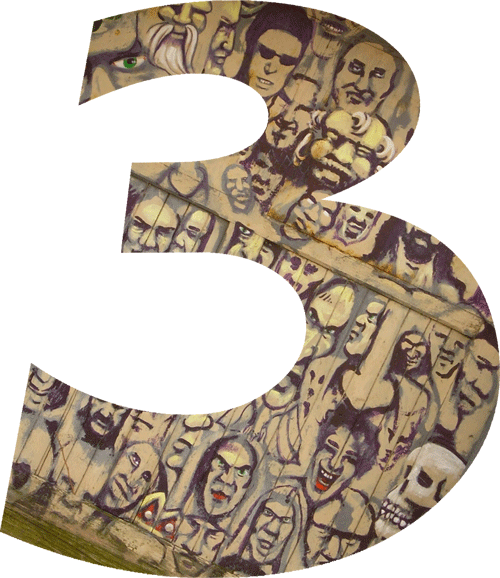 100 IDEAS THAT CHANGED GRAPHIC DESIGN
100 IDEAS THAT CHANGED GRAPHIC DESIGN
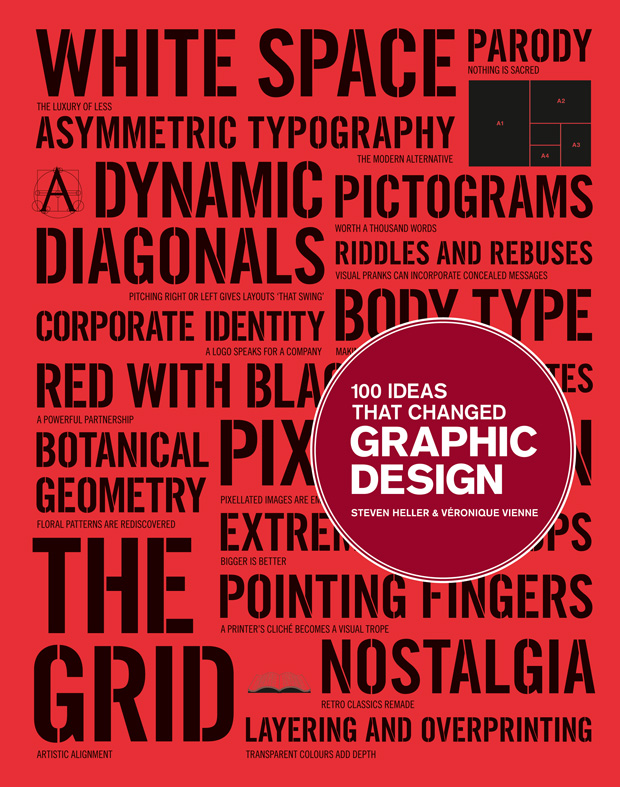 Design history books abound, but they tend to be organized by chronology and focused on concrete -isms. From publisher Laurence King, who brought us the epic Saul Bass monograph, and the prolific design writer Steven Heller with design critic Veronique Vienne comes 100 Ideas that Changed Graphic Design (public library) — a thoughtfully curated inventory of abstract concepts that defined and shaped the art and craft of graphic design, each illustrated with exemplary images and historical context.
Design history books abound, but they tend to be organized by chronology and focused on concrete -isms. From publisher Laurence King, who brought us the epic Saul Bass monograph, and the prolific design writer Steven Heller with design critic Veronique Vienne comes 100 Ideas that Changed Graphic Design (public library) — a thoughtfully curated inventory of abstract concepts that defined and shaped the art and craft of graphic design, each illustrated with exemplary images and historical context.From concepts like manifestos (#25), pictograms (#45), propaganda (#22), found typography (#38), and the Dieter-Rams-coined philosophy that “less is more” (#73) to favorite creators like Alex Steinweiss, Noma Bar, Saul Bass, Paula Scher, and Stefan Sagmeister, the sum of these carefully constructed parts amounts to an astute lens not only on what design is and does, but also on what it should be and do.
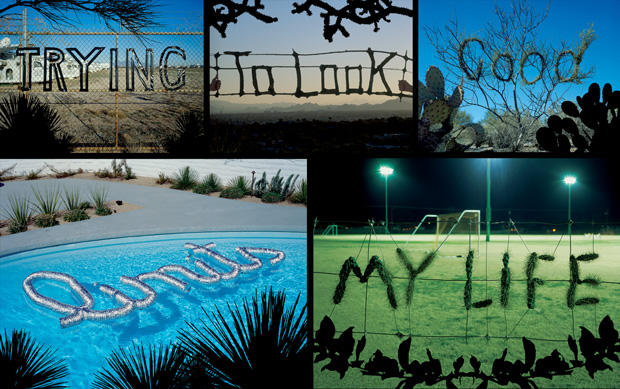
Idea # 16: METAPHORIC LETTERING
Trying to Look Good Limits My Life (2004), part of Stefan Sagmeister’s typographic project '20 Things I Have Learned in My Life So Far.' Words are formed from natural and industrial materials and composed in situ.
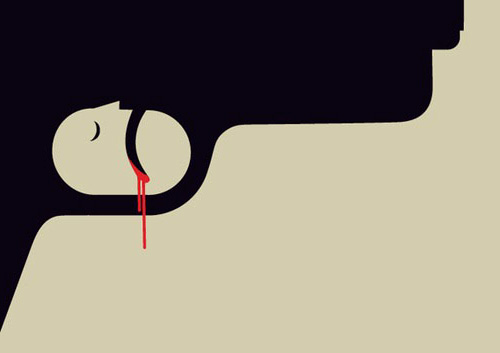
Idea # 19: VISUAL PUNS
Gun Crime (2010), illustrated by Noma Bar, is a commentary on the tragic toll of gun-related violence in the UK. The trigger serves as the mechanism and outcome of gun attacks.
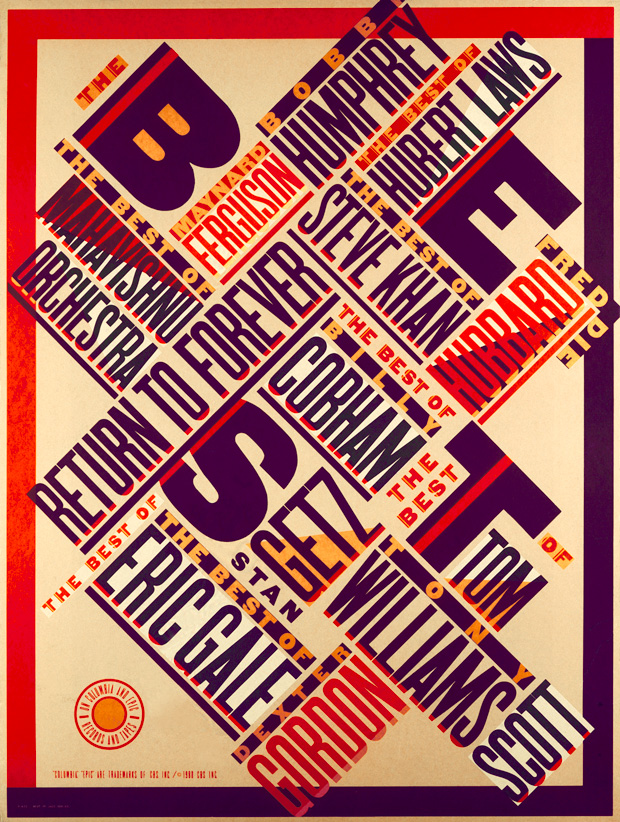
Idea # 48: TRIANGULATION
The Best of Jazz (1979), a typographical masterpiece by Paula Scher, was done when she was discovering Aleksander Rodchenko and El Lissitsky. She recalls her work being acclaimed as 'new wave' and 'postmodern' when in fact it was a private homage to the pioneers of the Russian avant garde.

Idea # 83: PSYCHEDELIA
Gebrauchsgraphik (1968). The youth style influenced by drugs and rock and roll quickly became a commercial visual vocabulary. Founded in San Francisco, this German version smoothed out some of the rough edges.
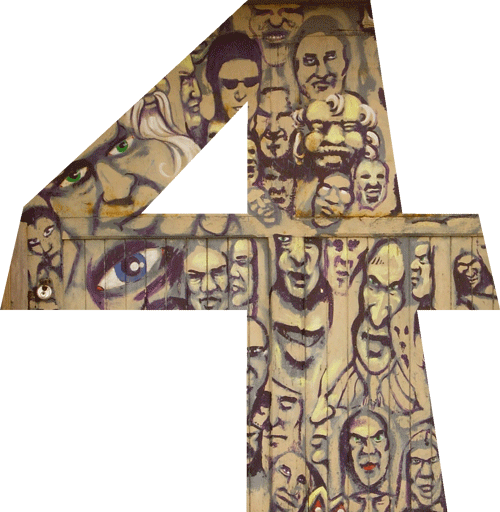 TRUE BELIEVERS
TRUE BELIEVERS
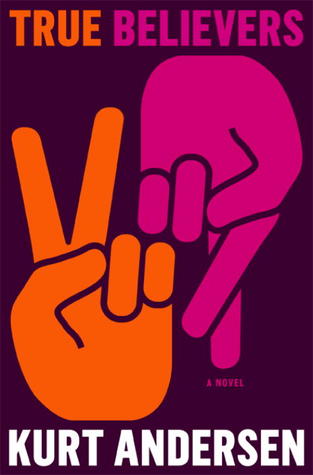 Having spent far longer than acceptable in a self-inflicted moratorium on fiction, I thought there was hardly anything more apt to get me back on the bandwagon than a galley from Studio360‘s Kurt Andersen. True Believers: A Novel (July 10) tells the story of 65-year-old Karen Hollander, an enormously successful attorney who has just recused herself from consideration for a U.S. Supreme Court position because of a secret she has kept for the past 40 years, since an unsettling event that took place in 1968, when Hollander was only 18. As she readies her memoir, in which she plans to reveal all, she sets out to tie some loose ends and find the answers to some vital last questions. Andersen takes us back to the 1960s to weave a timely story about counterculture and intellectual rebellion. But, as absorbing as the story is, what makes the novel spellbinding is Hollander’s fascinating, layered character — at once brilliant and irreverent, brimming with equal parts intelligence and humor.
Having spent far longer than acceptable in a self-inflicted moratorium on fiction, I thought there was hardly anything more apt to get me back on the bandwagon than a galley from Studio360‘s Kurt Andersen. True Believers: A Novel (July 10) tells the story of 65-year-old Karen Hollander, an enormously successful attorney who has just recused herself from consideration for a U.S. Supreme Court position because of a secret she has kept for the past 40 years, since an unsettling event that took place in 1968, when Hollander was only 18. As she readies her memoir, in which she plans to reveal all, she sets out to tie some loose ends and find the answers to some vital last questions. Andersen takes us back to the 1960s to weave a timely story about counterculture and intellectual rebellion. But, as absorbing as the story is, what makes the novel spellbinding is Hollander’s fascinating, layered character — at once brilliant and irreverent, brimming with equal parts intelligence and humor.And don’t be fooled by the eyeroll-inducing publisher synopsis (which features the phrase “kaleidoscopic tour de force of cultural observation and seductive storytelling”) — Andersen’s style is anything but self-important or clichéd; a master of simple yet tremendously evocative narrative, he moves swiftly between well-timed wit, without a hint of smugness, and (I’ll give Random House that) keen cultural observation.
See for yourself — you can read the first chapter here.
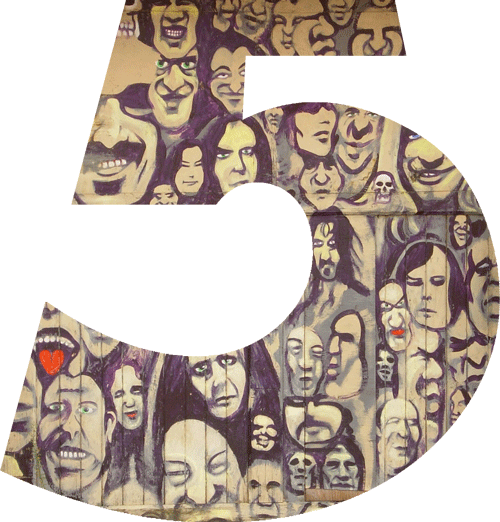 SEX AND PUNISHMENT
SEX AND PUNISHMENT
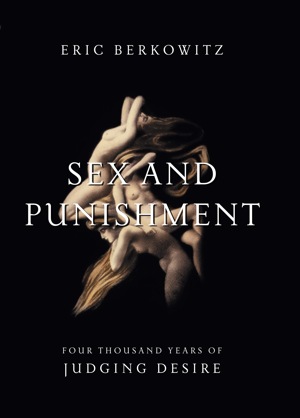 In Sex and Punishment: Four Thousand Years of Judging Desire (public library), writer and lawyer Eric Berkowitz explores the millennia-long quest to regulate and mandate one of the strongest drivers of human behavior, and the tragic deformities that result from the dictatorship of external authority over the most intimate of inner realities. (A subject all the timelier as we’re finally beginning to extinguish one of the most regrettable institutionally endorsed violations of basic human rights.) Tracing how we went from the male bonding ceremonies commonly performed in medieval Mediterranean churches to the lesbian executions in 18th-century Germany, along the entire spectrum of cultural attitudes towards mistresses, goat-lovers, prostitutes, medieval transvestites, adulterers, and other sexual-norm nonconformists, Berkowitz brings an eye-opening lens to one of the most mercilessly judged yet universal aspects of being human.
In Sex and Punishment: Four Thousand Years of Judging Desire (public library), writer and lawyer Eric Berkowitz explores the millennia-long quest to regulate and mandate one of the strongest drivers of human behavior, and the tragic deformities that result from the dictatorship of external authority over the most intimate of inner realities. (A subject all the timelier as we’re finally beginning to extinguish one of the most regrettable institutionally endorsed violations of basic human rights.) Tracing how we went from the male bonding ceremonies commonly performed in medieval Mediterranean churches to the lesbian executions in 18th-century Germany, along the entire spectrum of cultural attitudes towards mistresses, goat-lovers, prostitutes, medieval transvestites, adulterers, and other sexual-norm nonconformists, Berkowitz brings an eye-opening lens to one of the most mercilessly judged yet universal aspects of being human.In the period up to roughly the thirteenth century, male bonding ceremonies were performed in churches all over the Mediterranean. These unions were sanctified by priests with many of the same prayers and rituals used to join men and women in marriage. The ceremonies stressed love and personal commitment over procreation, but surely not everyone was fooled. Couples who joined themselves in such rituals most likely had sex as much (or as little) as their heterosexual counterparts. In any event, the close association of male-marriage ceremonies with forbidden sex eventually became too much to overlook as even more severe sodomy laws were put into place.A closer look here.
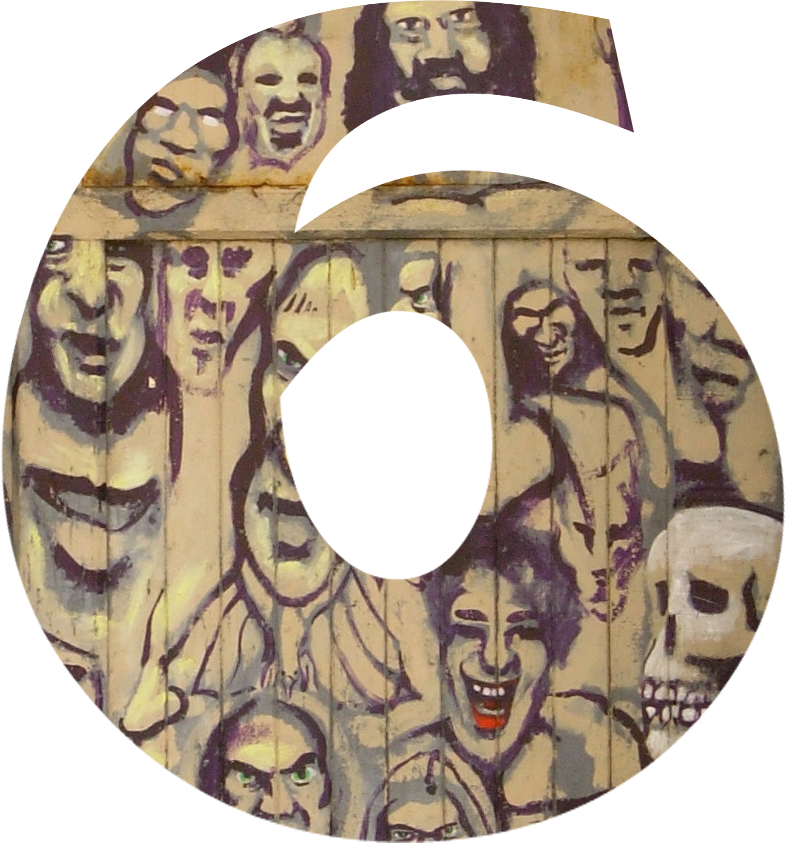 LITTLE BIRD
LITTLE BIRD
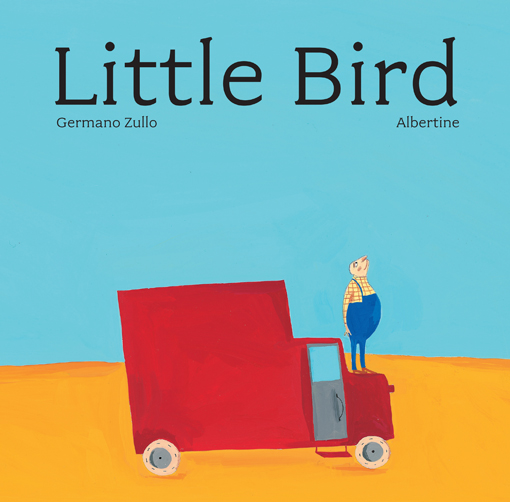 Children’s picture books — the best of them, at least — have this magical quality of speaking to young hearts with expressive simplicity, but also engaging grown-up minds with subtle reflections on the human condition. Such is the case of Little Bird (public library) by Swiss author-illustrator duo Germano Zullo and Albertine, published by the wonderful Enchanted Lion Books. Illustrated in Albertine’s signature style of soft, colorful minimalism, this little gem is like a beautiful silent film, only in vibrant hues and on paper — and if you’re reading to or with a little one this summer, it’s promised to induce many little oohs and ahhs.
Children’s picture books — the best of them, at least — have this magical quality of speaking to young hearts with expressive simplicity, but also engaging grown-up minds with subtle reflections on the human condition. Such is the case of Little Bird (public library) by Swiss author-illustrator duo Germano Zullo and Albertine, published by the wonderful Enchanted Lion Books. Illustrated in Albertine’s signature style of soft, colorful minimalism, this little gem is like a beautiful silent film, only in vibrant hues and on paper — and if you’re reading to or with a little one this summer, it’s promised to induce many little oohs and ahhs.It tells the tender story of a big-hearted man who halts his truck at a cliff’s edge. Unable to go any further, he opens the back door of his truck and a flock of birds spills out into the air, leaving behind a tiny, timid black bird. Surprised and delighted by the little loyalist, the man befriends the bird.
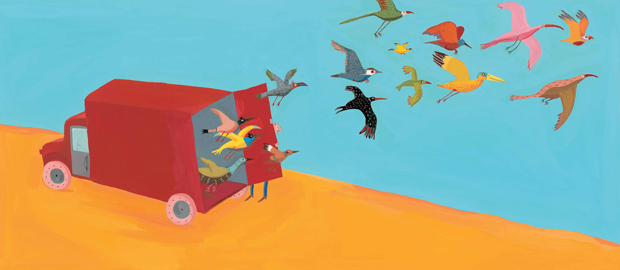
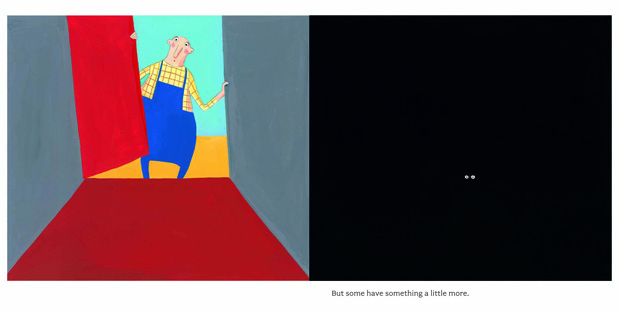


The two have lunch together and, eventually, the man tries to encourage the bird to fly off and join the others by attempting a comic demonstration of flight himself.
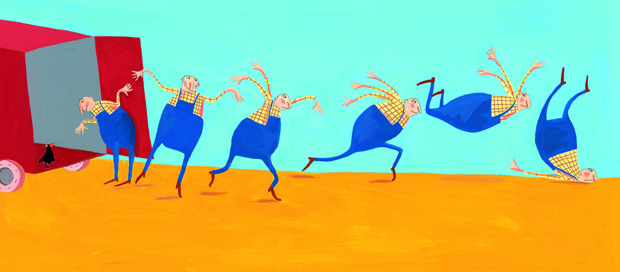
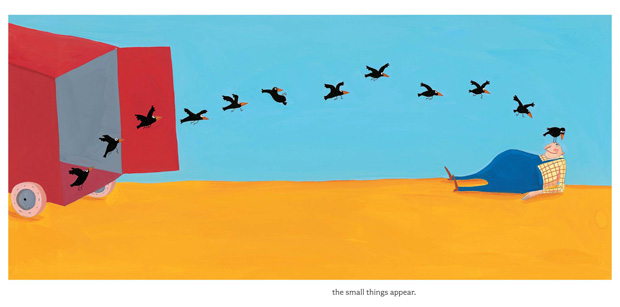
The humorous situation deepens the tenderness between the two creatures and soon the bird departs, the man drives away, and the story seems to end — but! — just as the truck trails off into the distance, we see the little black bird come back after it, followed by his colorful friends in a lyrical moment of belonging lost and found. “The small things are treasures,” writes Zullo. “True treasures.”
Take a closer look, with more beautiful artwork from the book, here.
 THE HOUSEHOLD TIPS OF THE GREAT WRITERS
THE HOUSEHOLD TIPS OF THE GREAT WRITERS
 Household chores. We dread them, we put them off indefinitely, we think of them as anything but entertainment. But here comes The Household Tips of the Great Writers (public library) — an imaginative and impossibly humorous omnibus of literary impersonation by parodist extraordinaire Mark Crick, who guides us through the art and craft of cooking, gardening, and fixing up the house with the help of some of modern history’s most celebrated literary icons. The real joy of the book, of course, isn’t so much the specific recipes and tips — though who could resist a quick miso soup à la Kafka? — as the comedic precision with which Crick caricatures, lovingly, each writer’s voice.
Household chores. We dread them, we put them off indefinitely, we think of them as anything but entertainment. But here comes The Household Tips of the Great Writers (public library) — an imaginative and impossibly humorous omnibus of literary impersonation by parodist extraordinaire Mark Crick, who guides us through the art and craft of cooking, gardening, and fixing up the house with the help of some of modern history’s most celebrated literary icons. The real joy of the book, of course, isn’t so much the specific recipes and tips — though who could resist a quick miso soup à la Kafka? — as the comedic precision with which Crick caricatures, lovingly, each writer’s voice.From boarding the attic with Edgar Allan Poe (“Working from the corner furthest from the feeble light source, which scarce illuminated my labours, I began to lay the boards. Those dark recesses, unlooked upon since the cloak of slate first enveloped them in eternal night, resisted my intrusion like the densest thicket.”) to putting up a garden fence with Hunter S. Thompson (“He lifted a size-eleven foot onto the spade, his leg peeking coquettishly through the slit trouser leg, and the blade sank into the ground. There was a lot to do.”) to burying bulbs in autumn with Sylvia Plath (“I swallowed trying again to clear the bitter taste from my mouth then I tipped the bulbs from the bag and watched as their fat little bodies rolled around on the garden path.”), Crick has all your household and gardening needs and emergencies covered.
Sample some of the recipes and all too delightful instructions here.
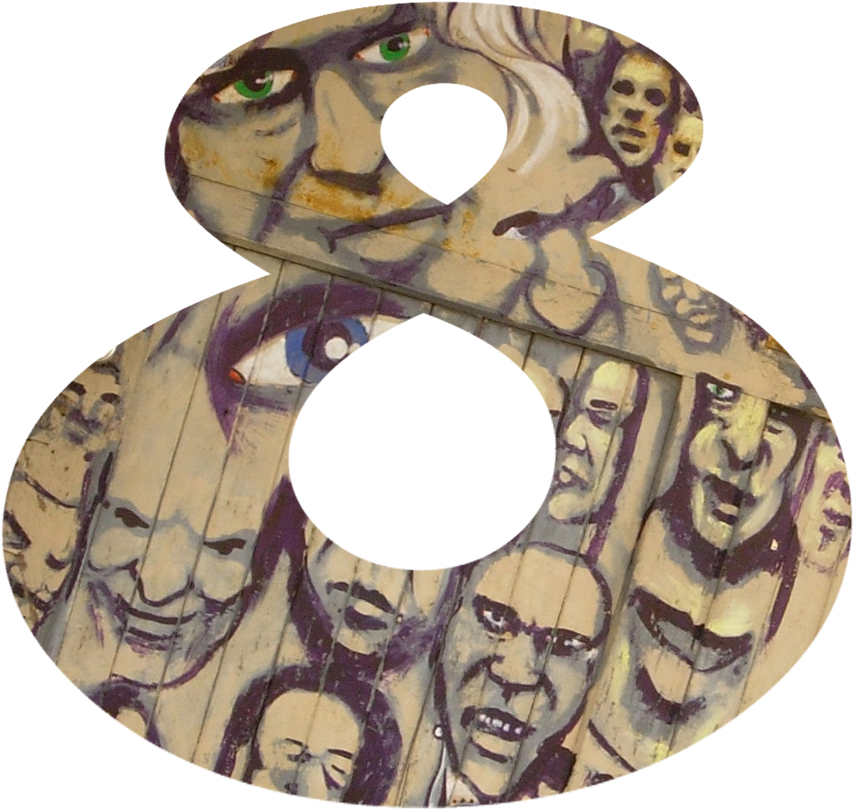 THE (HONEST) TRUTH ABOUT DISHONESTY
THE (HONEST) TRUTH ABOUT DISHONESTY
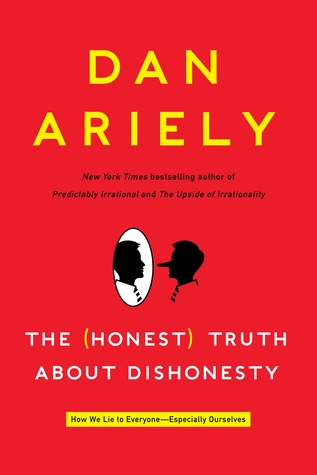 Behavioral economist Dan Ariely belongs to the rare breed of scientists who are both actively engaged in empirical research, running all kinds of fascinating experiments in the lab, and keenly skilled in synthesizing those findings into equally fascinating insights into human nature, then communicating those articulately and engagingly to a non-scientist reader. That’s precisely what he has previously done in Predictably Irrational, in which he demonstrates through clever experiments that even our most “rational” decisions are driven by our hopelessly emotional selves, and The Upside of Irrationality, where he explores the unexpected benefits of defying logic. Now comes The (Honest) Truth About Dishonesty: How We Lie to Everyone — Especially Ourselves (public library), in which Ariely asks himself a seemingly simple question — “is dishonesty largely restricted to a few bad apples, or is it a more widespread problem?” — and goes on to reveal the surprising, illuminating, often unsettling truths that underpin the uncomfortable answer. Like cruelty, dishonesty turns out to be a remarkably prevalent phenomenon better explained by circumstances and cognitive processes than by concepts like character.
Behavioral economist Dan Ariely belongs to the rare breed of scientists who are both actively engaged in empirical research, running all kinds of fascinating experiments in the lab, and keenly skilled in synthesizing those findings into equally fascinating insights into human nature, then communicating those articulately and engagingly to a non-scientist reader. That’s precisely what he has previously done in Predictably Irrational, in which he demonstrates through clever experiments that even our most “rational” decisions are driven by our hopelessly emotional selves, and The Upside of Irrationality, where he explores the unexpected benefits of defying logic. Now comes The (Honest) Truth About Dishonesty: How We Lie to Everyone — Especially Ourselves (public library), in which Ariely asks himself a seemingly simple question — “is dishonesty largely restricted to a few bad apples, or is it a more widespread problem?” — and goes on to reveal the surprising, illuminating, often unsettling truths that underpin the uncomfortable answer. Like cruelty, dishonesty turns out to be a remarkably prevalent phenomenon better explained by circumstances and cognitive processes than by concepts like character.We may not always know exactly why we do what we do, choose what we choose, or feel what we feel. But the obscurity of our real motivations doesn’t stop us from creating perfectly logical-sounding reasons for our actions, decisions, and feelings.A closer look, with a focus on the relationship between creativity and dishonesty, here.
[…]
We all want explanations for why we behave as we do and for the ways the world around us functions. Even when our feeble explanations have little to do with reality. We’re storytelling creatures by nature, and we tell ourselves story after story until we come up with an explanation that we like and that sounds reasonable enough to believe. And when the story portrays us in a more glowing and positive light, so much the better.
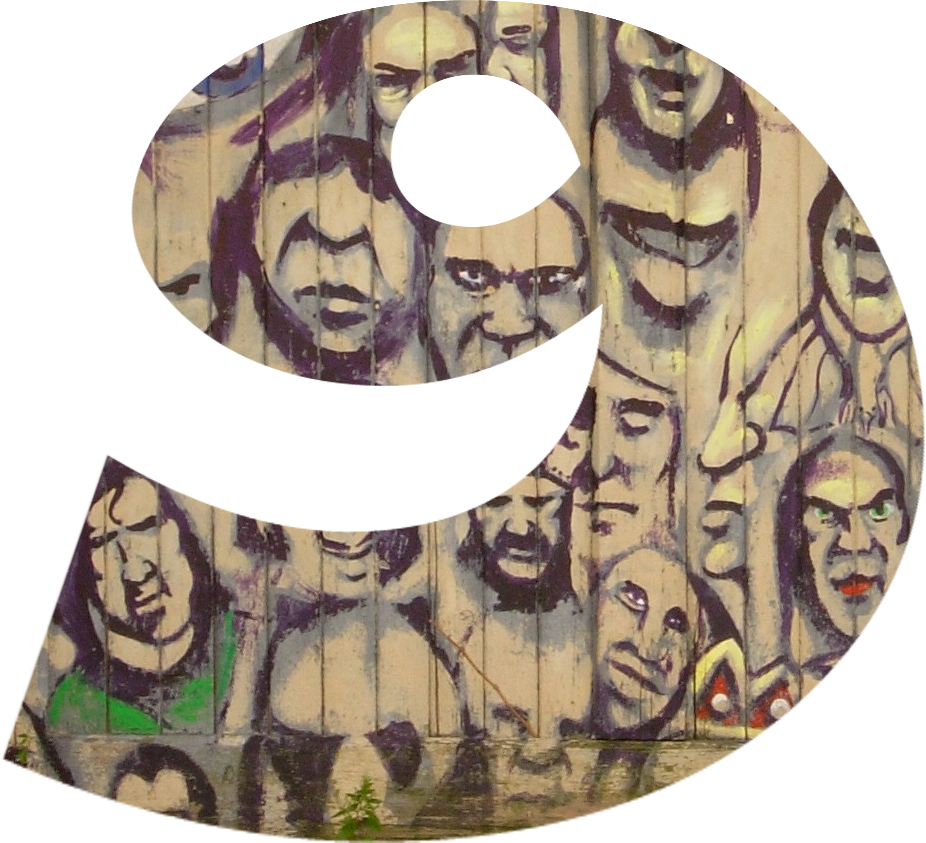 IGNORANCE: HOW IT FUELS SCIENCE
IGNORANCE: HOW IT FUELS SCIENCE
 “Science is always wrong,” George Bernard Shaw famously proclaimed in a toast to Albert Einstein. “It never solves a problem without creating 10 more.”
“Science is always wrong,” George Bernard Shaw famously proclaimed in a toast to Albert Einstein. “It never solves a problem without creating 10 more.”In the fifth century BC, long before science as we know it existed, Socrates, the very first philosopher, famously observed, “I know one thing, that I know nothing.” Some 21 centuries later, while inventing calculus in 1687, Sir Isaac Newton likely knew all there was to know in science at the time — a time when it was possible for a single human brain to hold all of mankind’s scientific knowledge. Fast-forward 40 generations to today, and the average high school student has more scientific knowledge than Newton did at the end of his life. But somewhere along that superhighway of progress, we seem to have developed a kind of fact-fetishism that shackles us to the allure of the known and makes us indifferent to the unknown knowable. Yet it’s the latter — the unanswered questions — that makes science, and life, interesting. That’s the eloquently argued case at the heart of Ignorance: How It Drives Science (public library), in which Stuart Firestein sets out to debunk the popular idea that knowledge follows ignorance, demonstrating instead that it’s the other way around and, in the process, laying out a powerful manifesto for getting the public engaged with science — a public to whom, as Neil deGrasse Tyson recently reminded Senate, the government is accountable in making the very decisions that shape the course of science.
The tools and currencies of our information economy, Firestein points out, are doing little in the way of fostering the kind of question-literacy essential to cultivating curiosity:
Are we too enthralled with the answers these days? Are we afraid of questions, especially those that linger too long? We seem to have come to a phase in civilization marked by a voracious appetite for knowledge, in which the growth of information is exponential and, perhaps more important, its availability easier and faster than ever.What emerges is an elegant definition of science:
Real science is a revision in progress, always. It proceeds in fits and starts of ignorance.In highlighting this commonality science holds with other domains of creative and intellectual labor, Firestein turns to the poet John Keats, who described the ideal state of the literary psyche as Negative Capability — “that is when a man is capable of being in uncertainties, Mysteries, doubts without any irritable reaching after fact & reason.” Firestein translates this to science:
Being a scientist requires having faith in uncertainty, finding pleasure in mystery, and learning to cultivate doubt. There is no surer way to screw up an experiment than to be certain of its outcome.An in-depth look, with a number of insightful quotes, here.
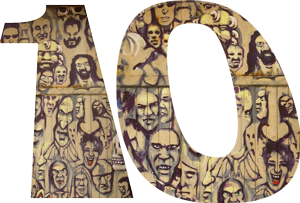 A HOLOGRAM FOR THE KING
A HOLOGRAM FOR THE KING
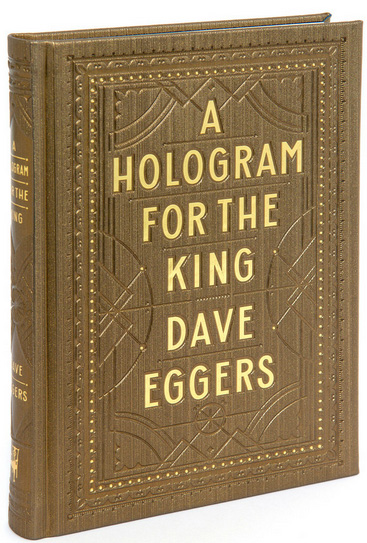 Already on the slippery slope to fiction (see above), I slid right into A Hologram for the King (June 19) by Dave Eggers — the story of a struggling middle-aged American salesman named Alan Clay, who makes one last attempt to extinguish his deep debt and save his family by setting out to entice the king of Saudi Arabia into buying bleeding-edge telecommunication technology. He goes from selling very tangible things like Schwinn bicycles to selling very ephemeral, virtual things like holograms, caught between the urgency of his situation and the discomfort of not really knowing what he’s doing. Like all great fiction, the novel becomes about all-too-real modern maladies — fraud syndrome, the friction of analog and digital, the painful disconnect between ambition and purpose.
Already on the slippery slope to fiction (see above), I slid right into A Hologram for the King (June 19) by Dave Eggers — the story of a struggling middle-aged American salesman named Alan Clay, who makes one last attempt to extinguish his deep debt and save his family by setting out to entice the king of Saudi Arabia into buying bleeding-edge telecommunication technology. He goes from selling very tangible things like Schwinn bicycles to selling very ephemeral, virtual things like holograms, caught between the urgency of his situation and the discomfort of not really knowing what he’s doing. Like all great fiction, the novel becomes about all-too-real modern maladies — fraud syndrome, the friction of analog and digital, the painful disconnect between ambition and purpose.In an altogether excellent interview on The Rumpus, Eggers ties the plot back to a particularly pressing aspect of socioeconomic reality:
Alan is like a lot of people who rightly or wrongly feel the current system is suffocating a lot of non-digital business ideas. A guy like Alan has knowledge and experience and maybe even a good idea, but can’t get a loan to save his life. He proposes making bikes in the U.S. again, but he gets laughed out of every bank, every venture capital firm. That’s a reality for a lot of guys like him, especially if they’re trying to do small-to-midscale manufacturing in the U.S. — meanwhile, some very dubious digital ideas have money thrown at them without hesitation.As a lover of the exquisite physicality of print books, I also couldn’t help but gasp at the thick, stunning foil-stamped typographic cover with a blind-deboss in gold ink, designed by none other than Jessica Hische:
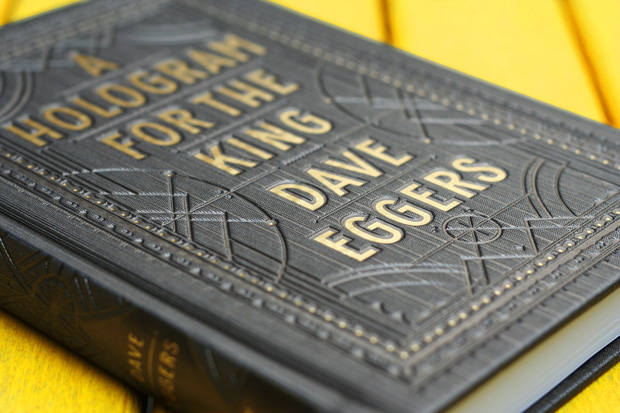
 Brain Pickings has a free weekly newsletter and people say it’s cool. It comes out on Sundays and offers the week’s best articles. Here’s what to expect. Like? Sign up.
Brain Pickings has a free weekly newsletter and people say it’s cool. It comes out on Sundays and offers the week’s best articles. Here’s what to expect. Like? Sign up.

No comments:
Post a Comment